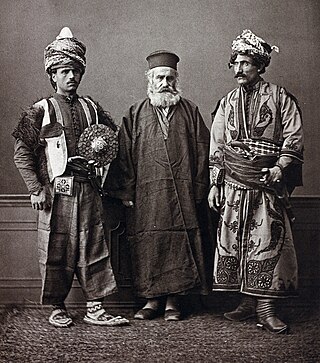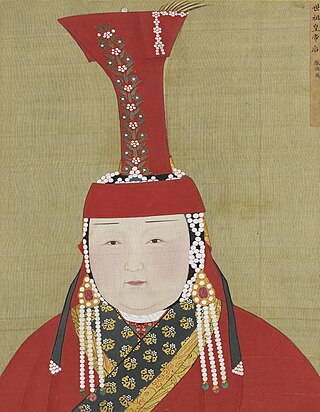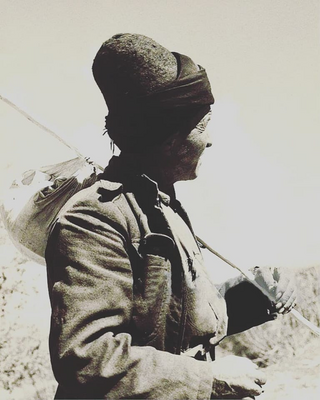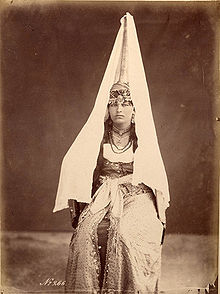
The fez, also called tarboosh/tarboush, is a felt headdress in the shape of a short cylindrical, truncated (peakless) hat, usually red, and sometimes with a black tassel attached to the top. The name "fez" refers to the Moroccan city of Fez, where the dye to color the hat was extracted from crimson berries. However, its origins are disputed.

Pascal Sébah (1823–1886) was a photographer in Constantinople and Cairo, who produced a prolific number of images of Egypt, Turkey and Greece to serve the tourist trade.

A hat is a head covering which is worn for various reasons, including protection against weather conditions, ceremonial reasons such as university graduation, religious reasons, safety, or as a fashion accessory. Hats which incorporate mechanical features, such as visors, spikes, flaps, braces or beer holders shade into the broader category of headgear.

Pointed hats have been a distinctive item of headgear of a wide range of cultures throughout history. Although often suggesting an ancient Indo-European tradition, they were also traditionally worn by women of Lapland, the Japanese, the Mi'kmaq people of Atlantic Canada, and the Huastecs of Veracruz and Aztec. The Kabiri of New Guinea have the diba, a pointed hat glued together.

Ottoman clothing or Ottoman fashion is the style and design of clothing worn during the Ottoman Empire.

The hennin was a headdress in the shape of a cone, steeple, or truncated cone worn in the Late Middle Ages by European women of the nobility. They were most common in Burgundy and France, but also elsewhere, especially at the English courts, and in Northern Europe, Hungary and Poland. They were little seen in Italy. It is unclear what styles the word hennin described at the time, though it is recorded as being used in French areas in 1428, probably before the conical style appeared. The word does not appear in English until the 19th century. The term is therefore used by some writers on costume for other female head-dresses of the period.

The kokoshnik is a traditional Russian headdress worn by women and girls to accompany the sarafan. The kokoshnik tradition has existed since the 10th century in the ancient Russian city Veliky Novgorod. It spread primarily in the northern regions of Russia and was very popular from 16th to 19th century. It is still to this day an important feature of Russian dance ensembles and folk culture and inspired the Kokoshnik style of architecture.

Fashion in the period 1500–1550 in Western Europe is marked by very thick, big and voluminous clothing worn in an abundance of layers. Contrasting fabrics, slashes, embroidery, applied trims, and other forms of surface ornamentation became prominent. The tall, narrow lines of the late Medieval period were replaced with a wide silhouette, conical for women with breadth at the hips and broadly square for men with width at the shoulders. Sleeves were a center of attention, and were puffed, slashed, cuffed, and turned back to reveal contrasting linings.

Fashion in 15th-century Europe was characterized by a series of extremes and extravagances, from the voluminous robes called houppelandes with their sweeping floor-length sleeves to the revealing doublets and hose of Renaissance Italy. Hats, hoods, and other headdresses assumed increasing importance, and were draped, jewelled, and feathered.

Fashion in fourteenth-century Europe was marked by the beginning of a period of experimentation with different forms of clothing. Costume historian James Laver suggests that the mid-14th century marks the emergence of recognizable "fashion" in clothing, in which Fernand Braudel concurs. The draped garments and straight seams of previous centuries were replaced by curved seams and the beginnings of tailoring, which allowed clothing to more closely fit the human form. Also, the use of lacing and buttons allowed a more snug fit to clothing.

Sidon's Sea Castle was built by the crusaders in the thirteenth century as a fortress of the holy land. It is one of the most prominent historical sites in the port city of Sidon, Lebanon.

A Dolly Varden, in this sense, is a woman's outfit fashionable from about 1869 to 1875 in Britain and the United States. It is named after a character in Charles Dickens, and the items of clothing referred to are usually a hat or dress.

Headgear, headwear, or headdress includes any element of clothing which is worn on one's head, including hats, helmets, turbans and many other types. Headgear is worn for many purposes, including protection against the elements, decoration, or for religious or cultural reasons, including social conventions.

A draped turban or turban hat is a millinery design in which fabric is draped to create headwear closely moulded to the head. Sometimes it may be stiffened or padded, although simpler versions may just comprise wound fabric that is knotted or stitched. It may include a peak, feather or other details to add height. It generally covers most or all of the hair.

History of clothing in the Indian subcontinent can be traced to the Indus Valley civilization or earlier. Indians have mainly worn clothing made up of locally grown cotton. India was one of the first places where cotton was cultivated and used even as early as 2500 BCE during the Harappan era. The remnants of the ancient Indian clothing can be found in the figurines discovered from the sites near the Indus Valley civilisation, the rock-cut sculptures, the cave paintings, and human art forms found in temples and monuments. These scriptures view the figures of human wearing clothes which can be wrapped around the body. Taking the instances of the sari to that of turban and the dhoti, the traditional Indian wears were mostly tied around the body in various ways.

An escoffion was a piece of female medieval headwear which was popular during the Late Middle Ages (1250–1500). It originated and was popular in European countries such as England, France and Germany, and other Balkan states. The headpiece was made out of a thick, circular roll of material like wool, felt or silk. The material was shaped, by sewing or starching, into a double-horned configuration, with each horn sometimes being up to a yard long. Over the headdress, gauze or silk was sometimes draped for weight distribution or aesthetic purposes. The escoffion style was a sub-branch of a popular style of headwear called hennin.

The Byblos figurines or Phoenician statuettes are approximately 1,500–2,000 ex-voto statuettes found in ancient Phoenician temples in Lebanon, primarily in Byblos, but also in Kamid al lawz. The statuettes date to the second millennium BC and are made of bronze, silver, or copper alloy. The Byblos figurines are considered to represent the best example of their kind across the Levant.

Gugu hat is a tall headdress worn by Mongol noblewomen before and during the Yuan dynasty. It is also known as boqta,boghta,botta, boghtagh or boqtaq. The gugu hat was one of the hallmark headdress of Mongol women in the 13th and 14th century. It was always worn with the formal robe of Mongol women.

The Labbadeh, also spelled as Lebbadeh, Lubbaddah, Labbade or Labbada is a conical brimless felt cap traditionally worn by Lebanese men.























